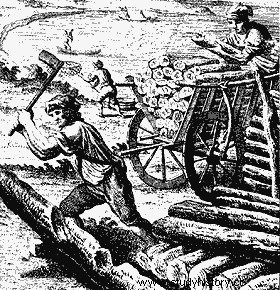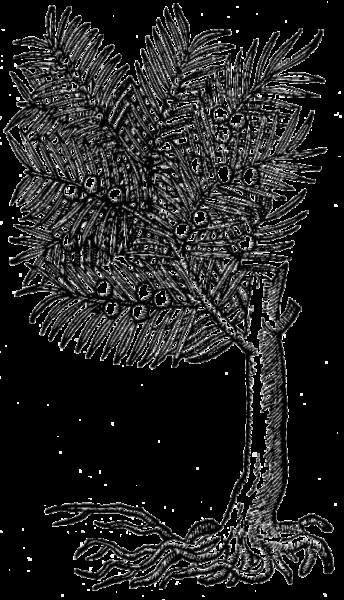After the retreat of the glacier from what is now Poland, trees tirelessly occupied the stripped plains ... until the time when man appeared.
The ice sheet left behind gigantic plains cut by riverbeds formed by slow melting. It was then, around 12,500 years ago, that trees began an arduous process of land reclamation that would turn into mature forests after millennia. When it finally happened, a new threat emerged:the human!
At first, there were few trees. The tundra transformation process was started by not very tall willows with sea buckthorn and eight-petal oak, after which it was time for birches, and then pines, spruces and alders. Along with the warming of the climate, species preferring milder temperatures appeared more and more often in the Polish Lowlands. This is how oak, linden, elm and ash came to our site. 6,000 years have passed since the glacier left. Pines found their niche in places where the soil did not offer very good conditions, while more fertile habitats were covered by mature, multi-generational, large-scale forests.
About 3000 BC a cooling began, which led to gradual changes in the species composition:beech and hornbeam gained more places for themselves. During this period, people and their settlements were already present and began to influence the nature around them more and more ...
Cornucopia
The first settlements appeared on the Vistula, Oder and Warta rivers. People who decided to settle permanently were no longer engaged in hunting and fishing:they preferred to grow plants and raise cattle, and thus - needed permanent shelter.
It all started innocently, from harvesting wood for building houses, for firewood, and for making tools. People living in the forests of today's Poland used the forest in a way - according to historians - not very expansive, until agriculture appeared. The growing populations of settlements required more and more land for cultivation, so the burning of trees on the best soil began.

Deforestation. A print from the 18th century.
It was not until the 12th century that the arable lands separated by a clear border from the forests. There was still more than enough forest around, and moreover, many rulers deliberately cared for the swamps and impenetrable forests surrounding their kingdoms. They knew perfectly well the strategic importance of these places, which played a role similar to that of rivers and lakes.
At the same time, game living among the trees provided the inhabitants with food. From the perspective of the man of the time, the forest must have seemed endless, and the resources it offers - infinite ... That is why it was used without moderation for a long time, which is best demonstrated by the statistics from those times. For example, in the 7th and 8th centuries in the Chełmno Land, one ecumen had about 10,180 hectares of forest, and in the 12th century it was only 1030 hectares.
Carved into the trunk
In view of such obvious losses in the forest surface, it was necessary to introduce rules regulating their use. And so, in the 12th century, privileges began to be introduced, allowing the use of the forest according to certain rules. For example, the Cistercians from Kołbacz Abbey in Pomerania could, under the privilege of 1185, use prince's forests to graze cattle and obtain construction timber. Certain areas of the forest were also protected against logging and transformation into an arable field, such as the forest growing at Święta (Grudziądz district), which was under protection in 1314.

Taxus baccata - cis
The first tree species highlighted for conservation was yew. Formerly common, due to its excellent properties (weapons were made of it, used as structural elements, and later also exported), it was depleted and reduced to the risk of extinction. For this reason, it became the first species of plant to be legally protected - as early as in 1423, Władysław Jagiełło ordered under the Statute of Warcraft:by the Lord or heir captured […] ”. Despite being legally protected so early, large amounts of yew wood were harvested in the 19th century, and the population of this tree only recently began to enter the phase of re-expansion.
Development Price
In later years, with the development of exports and the shipbuilding industry, the demand for forest products continued to increase. Ashes for the production of potash, tar and tar were obtained. In 1570, there were 50 sawmills in Royal Prussia alone!
According to Stanisław Staszic's “Statistics of Poland”, forests occupied 51.66% of the country's territory before the partitions. In 1778, King Stanisław August officially took a position on the decline in forest cover, issuing the "Universal for forests and forests in the Crown y in the Grand Duchy of Lithuania". "[...] Citizens of the Commonwealth of Poland do not retain any moderation in logging Bory, but, seduced by the hope of perishable profits regardless of a decent department together, ravage their own forests [...]" - we read in the document. However, the development of industry won with the royal call (the ruler did not impose any sanctions for logging, but only appealed to the common sense of his subordinates), the development of mining, railroads and agriculture in the 17th - 19th centuries caused a further decline in forest cover.

Foundation charter, forest clearing and construction of a miniature village from around 1300.
The lowest values were recorded in 1945, when the percentage of the country covered by forest was only 20.8%. It was only then that trees began to be planted on a large scale - however, the focus was on fast-growing species that bring economic profit, i.e. Scots pine in the first place, as well as poplars, larches and birches. The effects can be seen in forests to this day in the form of impoverished ecosystems, which, thanks to modern forest management, are slowly reaching maturity.
According to the long-term plan to increase forest cover, next year it should reach 30% of the country's area, and by 2050 - 33% . This process is very long and laborious, which additionally makes it difficult to reconcile with the ongoing forest management. It remains to keep your fingers crossed for the foresters…
Bibliography:
- Grzywacz., A., Problems of interpretation of the provisions of the Warcki Statute of 1423 in the field of yew protection. Sylvanus. 3, 2008
- Act of 28 September 1991 on forests (consolidated text)
- Wiśniewski, J., Gwiazdowicz, D., Nature protection. Publishing House of the University of Life Sciences in Poznań, Poznań, 2009
- Zajączkowski, G., Jabłoński, M., Jabłoński, T., Małecka, M., Kowalska, A., Małachowska, J., Piwnicki, J., Report on the condition of forests in Poland 2016. State Forests Information Center , Warsaw, 2017
